By Edmund H. Giraud
and a short history of the La Fontaine family by James La Fontaine - 1934
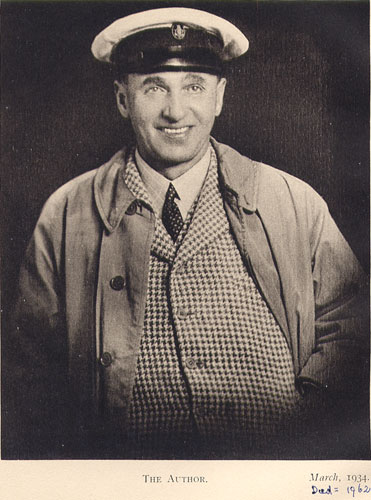 |
PREFACE
The papers that follow contain a simple and unvarnished picture of the origin and offspring of two families that came to a strange land over one hundred and fifty years ago and have succeeded in making their names respected in the land of their adoption.
These two families were founded by three men who reached Smyrna many generations ago, very young, unmarried and quite friendless in the country of their adoption, but determined to succeed.
Their descendants are numerous. Some have gone out to other lands, but many remain in the land of their adoption and the names of these two families are very highly respected.
The lives and examples of the founders and their descendants may safely be used to inspire the present generation, and it is hoped that what is now about to be set forth may be of some interest to those of the family who are living in Turkey to-day and of some help to those who are to follow and may wish at times to think of their predecessor. The history will certainly be of no interest to the public, and it is not written for this purpose. But if it serves to interest and help the present-day descendants and those to follow of Jean Baptiste Giraud of Antibes in France, who came to Turkey about 1780, and of Charlton Whittall and his younger brother, James Whittall, both of Liverpool, who reached Smyrna in 1808 and about 1812 respectively, then I shall feel amply rewarded for the trouble taken, amongst the more arduous occupations of an active commercial career.
The task of tracing the descendants of our forefathers in this land of Turkey has been rendered difficult by gaps in the Consular and Church records, by the destruction of archives in the fire of 1922, and by the damage done to many of the cemeteries of Smyrna. My thanks are due to friends on the staffs of the French and British Consulates and among the Fathers of the Church of St. Polycarp in Smyrna, who have generously helped me in my researches.
The Dutch Consular Archives of Smyrna were completely destroyed in 1922.
I have derived the greatest assistance from the family records and papers of my Grandfather, James Whittall, of Smyrna, at present in the possession of his eldest grandson, Mr. Edwin Whittall, of Moda, Constantinople.
Without Mr. Edwin Whittall’s unfailing interest and assistance, these records could not have been printed in their present form.
Smyrna, 7 March, 1934
CONTENTS Page
The Giraud Family
The Giraud Family ... 1
The de Hochepieds ... 22
The Van Lenneps ... 24
Other Girauds of Turkey having no relation to our family ... 26
Ancestors of my Father and Mother ... 28
The Giraud Family Trees
Ancestry of Annette Giraud (née de Hochepied)
The Early Whittalls
The Early Whittalls ... 35
Family Tree of the Direct Line of the Early Whittalls ... 50
Family Tree - The Early Whittalls ... 51
My Great-grand aunt Mary Whittall’s diary ... 52
Resumé of the History of the Gerrard Family ... 61
The Whittalls of Turkey
The Whittalls of Turkey ... 63
The James Whittall Family ... 78
The James Whittall Family Trees ... 83
The Charlton Whittalls ... 99
The Charlton Whittall Family Tree ... 101
The James Whittalls (of Ceylon) ... 103
The Charlton Arthur Whittalls ... 104
Letters from Richard Whittall, dated Havanna, 20 May, 1841 ... 106
Letters from Richard Whittall, dated Havanna, 15 May, 1841 ... 106
Letters giving details of John Whittall’s death, dated San Francisco, 1st April, 1851 ... 109
Journal of an Excursion of “Plaisir” in July, 1830 ... 112
The La Fontaine Family
Our First Known Ancestors and Family Trees ... 119
The Early La Fontaines ... 125
Other La Fontaines who may be connected with our Family ... 129
The La Fontaines of Turkey ... 133
THE PAST
The Past is dead, men say - it is not so;
All that was known of old we may yet know.
The Past is but a name - so might a girl
That weaves a necklace, to each several pearl
Her hands relinquish, give the name of “Past”
And “Now” the gem she holds, and till the last,
Count each new pearl as lost that leaves her hand,
Nor mark the growing beauty of the strand.
The names departed which we name once more,
The dim remembered ways we trod of yore;
All these, the pearl relinquished of our hand,
Still shine eternal in the perfect strand.
Bournabat, 21 January 1932.
p. 1
The Giraud Family
My earliest ancestor known to have come to settle in Turkey was my great-great-grandfather, Jean Baptiste Giraud.
The finely painted portrait of this ancestor is in the possession to-day of my cousin, Mr. Edwin Whittall, of Moda, Constantinople.
Jean Baptiste Giraud was born at Antibes on the 4th August, 1742, of pure French stock. The family had been established for generations at or around Antibes in the south of France and were evidently people of substance. The register of births for the year 1742 of the Mairie of Antibes contains the following entry:-
| Etat Civil, no. 172, Naissance de Giraud, Jean Baptiste | Jean Baptiste Giraud, fils naturel de Jean icy présent, fils d’Alexandrie bourgois habité dans cette ville, lequel Jean nous a declaré étre le Père; et la Mère, Anne Scelle. En presence de Messire Antoine Isnard, prêtre de cette paroisse, de Jean Baptiste Regnard, Négociant, et de Demoiselle Anne Elisabeth Besin, le Parrain et la Marraine soussignés; Est né et baptisé le quatrième d’Aout Mille sept cens gurante deux par Moy, Curé soussigné Ont signé: Gairaud, Curé, Giraud, Regnard, Isnard Besin. |
I do not know precisely when and for what reason Jean Baptiste Giraud left his native land and came to settle permanently in Smyrna. My maternal grandfather, James Whittall, has left us the following information in his Family Records: “My maternal grandfather, Jean Baptiste Giraud, came and settled in Smyrna to escape the terrors of the Revolution of 1789”. It is very evident, however, that Jean Baptiste Giraud reached Smyrna long before 1789. He married in Smyrna a Smyrna lady, and his first child was born on the 25th February, 1789. This indicates that he had been in Smyrna some time before that date of his marriage, which could not have taken place later than early in the year 1788. Moreover, in his will, dated 29th December, 1810, he revokes an earlier will “qu’il se rapelle d’avoir fait à Marseille dans son dernier voyage fait en France en l’an mil sept cent quatre vingt huit.” All this clearly indicates that he had already settled in Smyrna before attaining the age of 45 in 1787. The fact that Jean Baptiste Giraud did not revisit his native land after 1788 may have been for the reasons that justified my grandfather’s record as above, and these same reasons may have caused him to settle definitely in Smyrna.
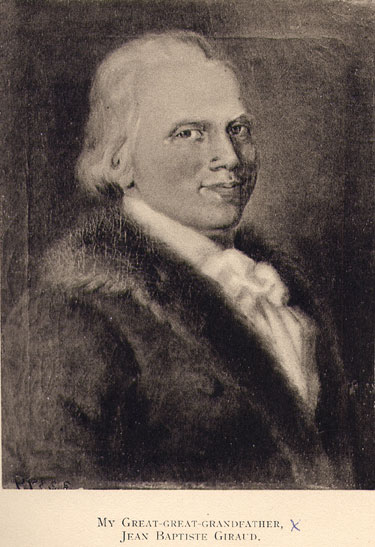 |
On the whole, it appears probable that Jean Baptiste Giraud came to Smyrna as a merchant at a fairly early age, possibly not later than 1780, when he was about 38 years of age, and about 28 years before Charlton Whittall, who became his son-in-law, and was the first of the Whittalls to come to Turkey. Admitting this, then Jean Baptiste Giraud, who died at the age of 69 years in 1811, and who was described in the Consular Records as “Négociant Francais établi depuis de longues années en cette Ville,” spent 31 years of his life in Smyrna.
Although Jean Baptiste’s birth certificate given above renders it fairly evident that neither his father, Jean, nor his mother, Anne Scelle, nor yet his grandfather, Alexandre, were ever domiciled in Turkey, for they are described as bourgeois residing at Antibes, yet it is possible, though unlikely, that some branch of the Giraud family at that time may have already had some connection with the Levant before Jean Baptiste himself came to Smyrna. This may account for the fact that other families in the Levant bear the same name but do not claim relationship with our family to-day.
Jean Baptiste Giraud became a merchant of eminence in Smyrna, trading under the name of J.B. Giraud et Cie. He occupied a leading position amongst the French community for a long time to the date of his death in 1811. His grandson, James Whittall, has placed on record that the fortune which Jean Baptiste Giraud had acquired was lost at the latter end of his career by the capture of two of his vessels by the British, which entailed the loss of two million francs. He further records that “this broke his heart, and at his death what remained to his family consisted chiefly of the Frankhané, now my property, his fine country house in Bournobat, now the property of Haji Costi, his furniture and family jewels.”
A letter from Monsieur Rostan, dated Marseilles, 24 Jber, 1806, to J.B. Giraud’s eldest son, Alexandre Giraud, refers to these losses in the following terms: “J’aurais été au déséspoir que ta mère eut fait le sacrifice de ses bijoux. Je me console plus facilement de celui que tu veux faire de ton cheval dans l’espoir que ce ne sera pas pour longtemps et que ton père se rempoura de ses pertes.” Monsieur Rostan, who writes this letter, is described in a letter of J.B. Giraud as “Mon Cousin, Mr. Jn. Foir Rostan, mon ancien ami.”
Some time after his arrival in Smyrna, probably about the year 1787, Jean Baptiste Giraud married Hélène Tricon, née Cortazzi, one of the daughters of the Venetian Consul, Lui Cortazzi, and his wife, the Contessa di Capo d’Istria.
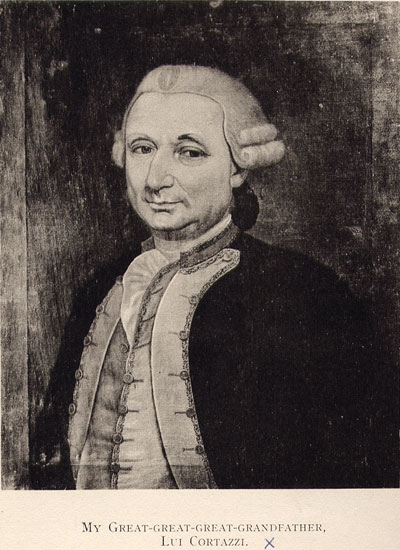 |
The Cortazzi family was one of the oldest and most illustrious families in the Levant at that time. Two other daughters, Jean Baptiste’s sisters-in-law, were Madame Fuibée, née Adrianoula Cortazzi, and Madame Majastre, née Marianne Cortazzi, who died in 1797, aged 38, and who is buried by the side of Jean Baptiste in the northern aisle of St. Polycarp’s Church at Smyrna.
My grandfather, James Whittall, who married one of the grandchildren of Jean Baptiste, and whose mother was Jean Baptiste Giraud’s only daughter, has placed on record knowledge acquired by him of the Giraud family which is of the greatest interest to us to-day. I quote from these records as follows:-
“Having no documents in my possession concerning this branch of my maternal ancestors, I can only write from hearsay. According to what I have heard from my mother and others, the Girauds in France lived at Antibes or neighbourhood, where their chateau may still exist and be in the possession of the family. To the best of my knowledge they were wealthy and enjoyed a reputable standing, if they were not of the petite noblesse, as my mother once told me.”
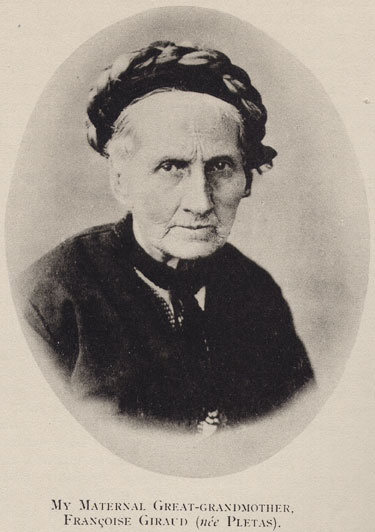 |
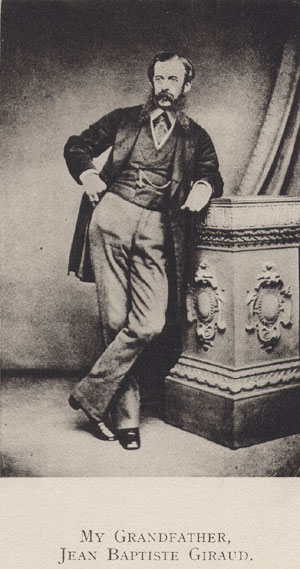 |
Note added in handwriting by Edmund Giraud Dec. 1940: First cousin to Mareshal Massena and his wife Prince & Princess d’Essling.
Re: Massena’s connection by marriage with the Giraud family:-
Since the publication of Family Records in 1934 I have been able to discover among some of my Father’s papers a number of letters addressed to J.B. Giraud in Smyrna from various members of his family in Antibes. These letters reach as far back as 1767 and end with a letter dated Antibes 18th April 1811, written by an aunt to the late J.B. Giraud’s on Alexander condoling with him over the death of his father which occured on the 8th January 1811. Among these letters are several dated according to the Calender of the Revolution such as 28 Juirinal an 9e - 9 Horidor an 13e - 1er Messidor an 13e. Amongst these letters I also discovered a copy of the will of Jean Giraud “Bourgeois de cette ville d’Antibes” dated “dans ma maison d’Antibes ce quatorze Décembre avant midi 1787.”
This will proves that my paternal Great-Great-Great Grandfather, Jean Giraud & his wife Anne Scelle had 5 daughters and one son. The daughters were named Anne, Marie Cecile, Blanche, Marianne and Reine. The son was of course, Jean Baptiste Giraud who was my earliest direct ancestor known to have come to settle in Turkey. He was born on the 4th August 1742 & he was already established in Smyrna in the year 1767. This last is clearly proved by a letter addressed to him by his father Jean from Antibes dated 6th May 1767, the original of which is in my possession. The will referred to above, by a somewhat fortunately worded digression establishes very clearly the relationship that existed between the Giraud family and the Mareshal Massena, the relationship neither my Grandfather James Whittall, nor my own researches to the time of the publication of “Family Records” in 1934 had succeeded in tracing with any degree of certainty at all (view pages 5 & 6 of this volume). I now quote from the will in question as follows:-
“Je lègue a Marie Giraud mon autre fille dénommée et reconnue dans la famille sous le nom Cécille pour la” “raison qu’on la croyait nommée Marie Cécile dans l’acte de Bapteme, la quelle a eu pour parrain Jean Baptiste Giraud” “mon fils et pour marraine Dame Marie Aubanel, épouse de Monsieur Joseph Lamarie sa Tante...”. It becomes abundantly clear from this that André Massena in marrying Marie Rosalie Lamarre on the 10th August 1789, daughter of Joseph Lamarre & his wife Marie Aubanel, as indicated on the marriage certificate quoted on page 6 of “Family Records”, became a first cousin by marriage to my Great-great-grandfather Jean Baptiste Giraud. The Maréchale Massena’s wife Marie Rosalie Lamarre was a niece of Jean Giraud of Antibes & the Maréchal’s mother-in-law was the Godmother as well as the aunt of Jean Baptiste’s sister Cécile.
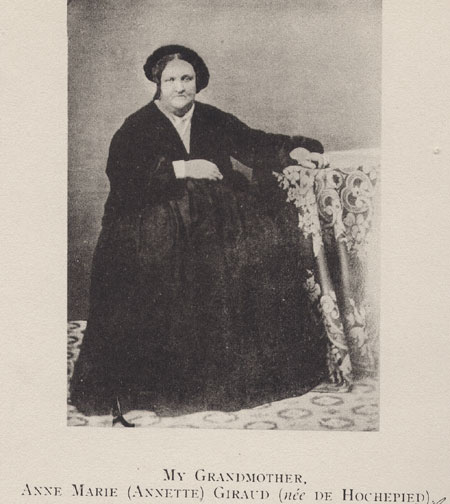 |
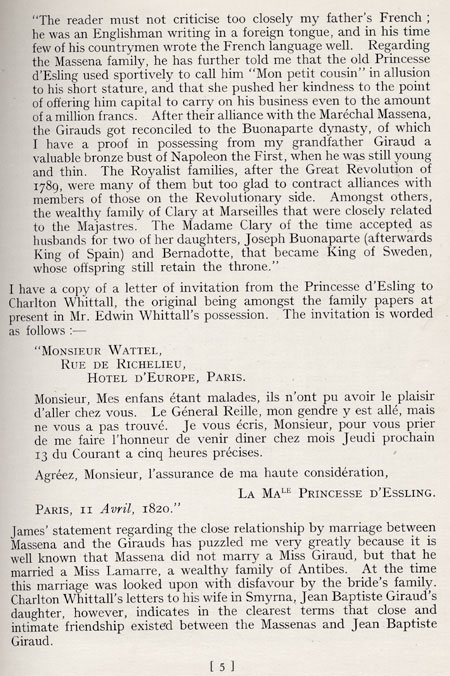 |
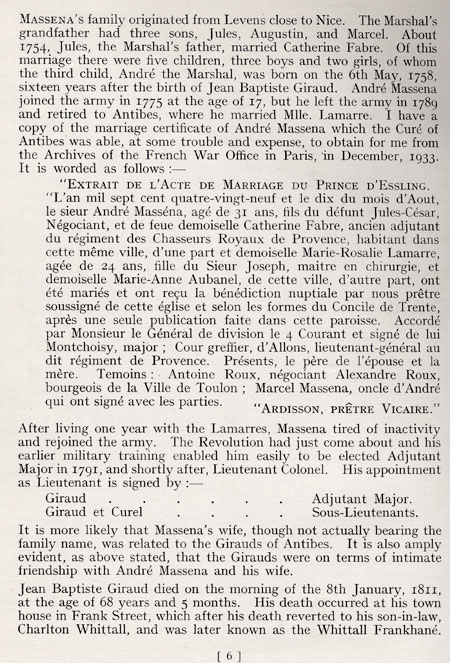 |
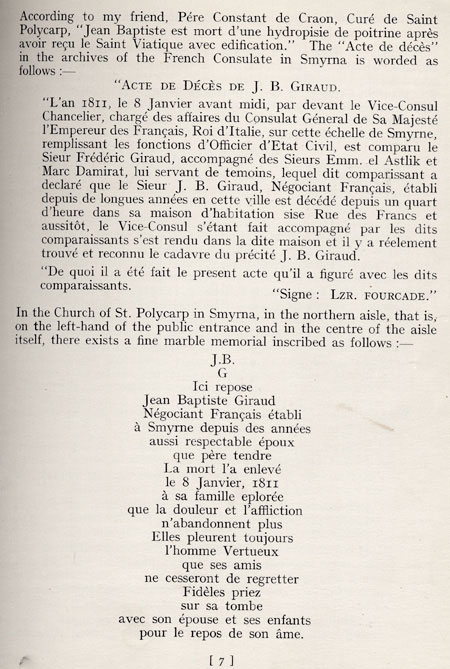 |
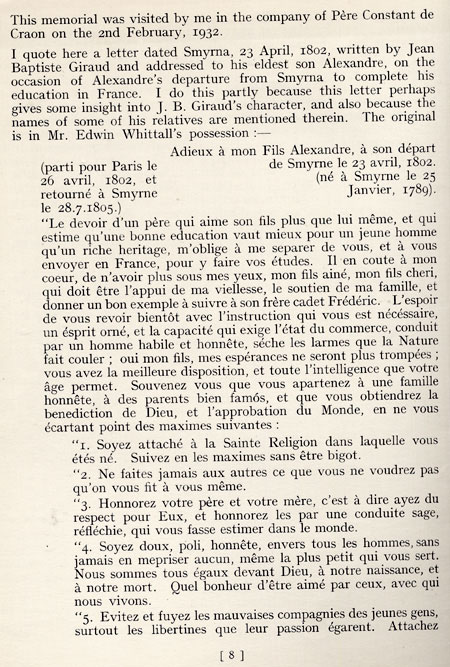 |
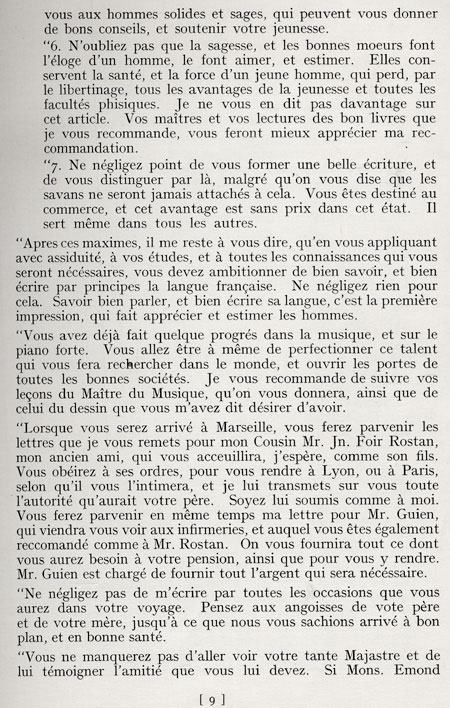 |
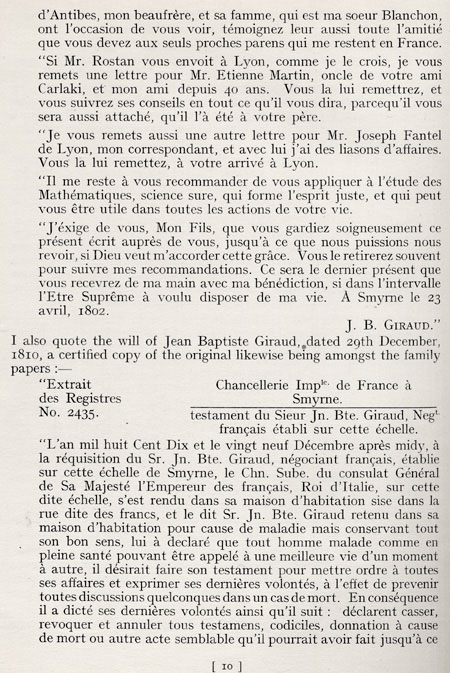 |
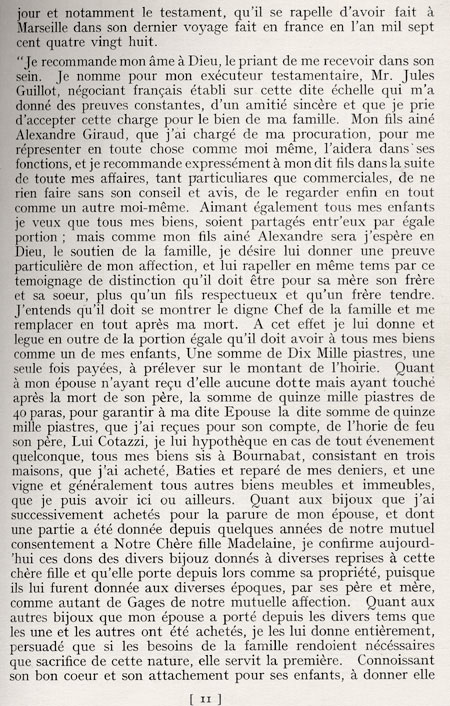 |
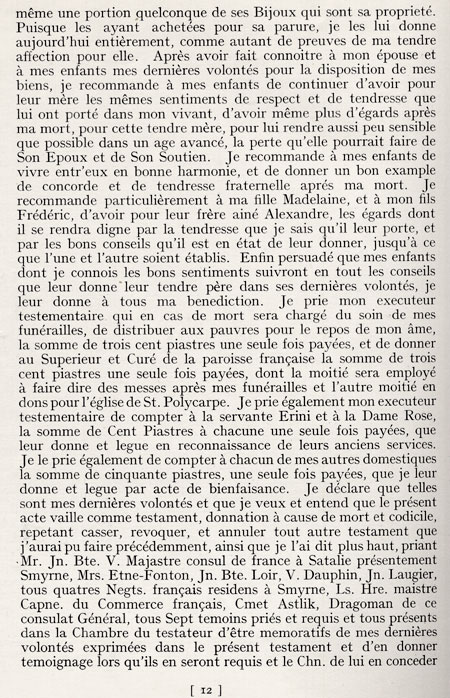 |
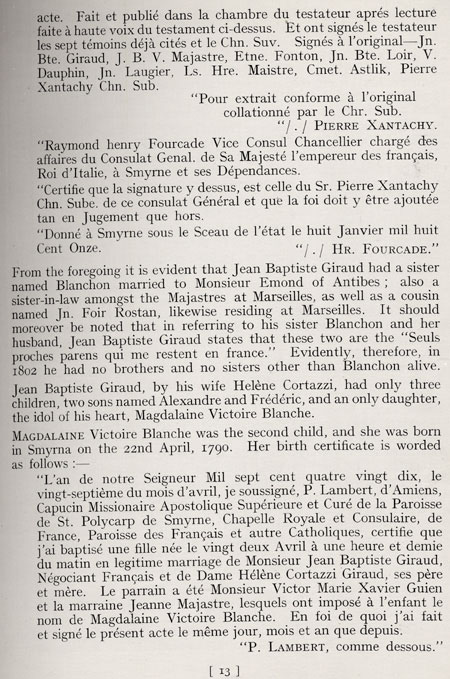 |
p.20
The other three children namely, my own father, Jacques Joseph Frédéric (Frederick), and my aunts Théophanie (Fanny) and Rowena, survived their parents, were married and each had several children. They are referred to in the pages that follow.
Frédéric, my father, was born in Smyrna and died in Athens at the age of 85. By reason of the hostilities in and around Smyrna in September, 1922, he had to leave his home in the country, which he loved and in which he had spent his life. This broke his heart and hastened his end. His wish that his body be brought back to Turkey was respected, and lies buried in the family plot in the Anglican Cemetery in Bournabat beneath the same stone that marks the last resting-place of his wife and life-long companion, my beloved mother. In his early youth, my father was greatly loved by his grand-uncle, Charlton Whittall, and was frequently invited to stay with and keep the old man company. Later on he married Charlton Whittall’s grand-daughter Mary, the second daughter of James Whittall. By this marriage he had five sons and one daughter, all living to this day, except the daughter, Magdalene Blanche Edith, who was born on the 22nd March, 1873, and died on the 27th October, 1875. She lies buried by the side of her parents. For most of his life, Frédéric Giraud was associated with the firm of C. Whittall & Co., and occupied chiefly with the export of dried fruits from and the import of iron into Smyrna. His most loyal assistant for many years was his chief clerk, Mr. John Michel. Before they were sent out into the world, each of his five sons was made to go through his office; under the strict hand of their father, tempered by the genial and modest companionship of the ever-faithful John, no better beginning could have been devised. Frédéric Giraud was a true product of the period. He was a thorough gentleman by nature and high principled to a degree that would not be easily understood in these days. He appeared to me to have an almost fanatical view of right and wrong, the product of a stern religious sense which he carried with him to his last days. He was nevertheless, a passionate man, impatient under contradiction, high-spirited, with an inexhaustible reserve of energy. He always led an active life, and was very fond of every form of sport that came within his reach; in all of which he indulged with that keenness and thoroughness which was part of his nature. At the same time, he was a hard, patient and meticulous worker. Sometimes (so it seemed to me), he allowed his passion for detail to limit or perhaps even to obscure his vision. In appearance he was of medium height, with fine features. He was light and active; he had an excellent figure, and was always perfectly well-dressed. He was in perfect health throughout his long and useful life, and was full of vitality until he reached his eightieth year. He died in 1922 at the age of 85 and was survived by his wife, who died ten years later, in 1932, at the age of 90. No family could possess more worthy parents in every sense of the word.
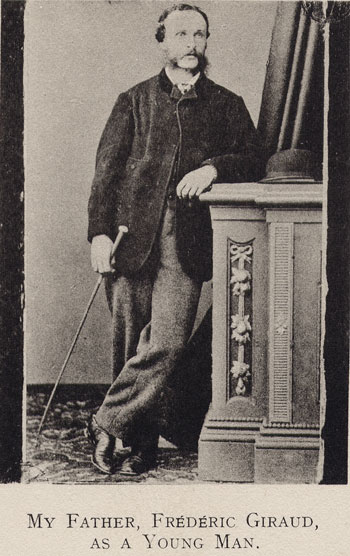 |
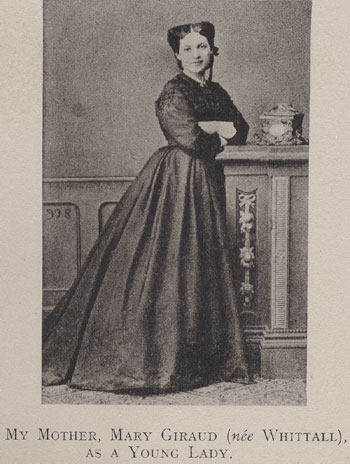 |
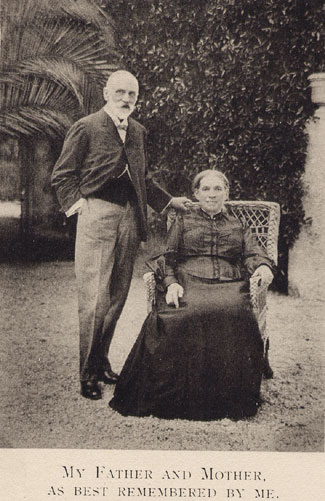 |
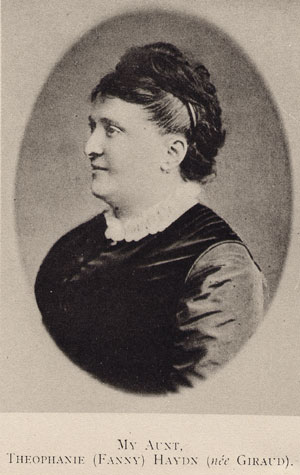 |
THEOPHANIE (my Aunt Fanny) was born in Smyrna on the 13th November, 1838, and she died in Italy at the age of 82 years. She married a Mr. Haydn, who was, according to my grandfather, James Whittall, a professor of music. By this marriage, Aunt Fanny had three children, Edmund, who died in India, Alfred, who is now living in Italy (my Aunt Fanny was residing with him at the time of her death), and a daughter named Athena, who died in Bournabat, unmarried, at the age of forty. Aunt Fanny had many traits of character in common with her brother Frédéric. Like him, she was high-spirited and impatient under contradiction, traits that often brought her into momentary and fortunately harmless conflict with her brother. A I remember her for many years, she was a stout and healthy old lady, short in stature, always bursting with life and energy and blest with a good appetite and equally good digestive powers. She gave to me and some of my brothers our first musical and religious instruction, and was often left to take charge of the house and family in the absence from home of my parents. She was for many years the mainstay of the Choir of St. Mary Magdalene’s Church Bournabat, as a tablet to her memory in that Church bears witness. As a widow, she lived for many years with her sister Rowena; but after her sister’s death in 1916 she left Turkey for Milan, where for some years before her death, which occurred in 1920 at the age of 82, she lived with her son Alfred.
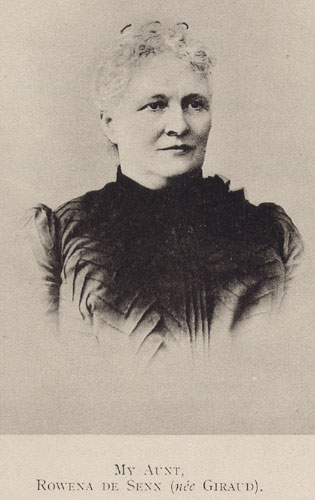 |
ROWENA, the third surviving child of Jean Baptiste Giraud, was born in Smyrna, and died in Smyrna in 1916 at the age of 68 years. She lies buried in the Anglican Cemetery in Bournabat by the side of her mother, Annette, née de Hochepied. She married a Swiss gentleman named P.C. de Senn, by whom she had eight children, three sons and five daughters. My Aunt Rowena, the youngest of J. B. Giraud’s children, offered a startling contrast, in many respects, to her brother Frédéric and sister Théophanie. She possessed none of the passionate traits of her brother and sister; she was gentle, mild-mannered and sweet-tempered to a degree. Her noble character and sweet disposition were a perfect accompaniment to her beautiful face and good features. Unfortunately for her own family and for all her relations and numerous friends, she died at an earlier age than her brother and sister, on the 9th April, 1916, at the age of 68. Her death was greatly mourned, for she was loved by all.
These three members of Jean Baptist Giraud’s family lived to see their children grow up and to have grandchildren and great-grand-children around them. In spite of the high spirit and hot blood of two of them, they were always much attached to each other. The mixture of Venetian and Dutch blood with the blood from the South of France may have had something to do with my grandfather’s strong character and strange career and with the marked traits of character in his offspring.
HELENE ELIZABETH, my grand-aunt and the other child of Frédéric and Marie, née Gion, first married the Count Edmond de Hochepied, a brother of Anne Marie de Hochepied. By this marriage, Héléne de Hochepied, née Gíraud, had only one child named Jacques de Hochepied. JACQUES DE HOCHEPIED married (i) Miss Homére (2) Henriette Van Lennep; he had one child, the Count Edmond de Hochepied, by his first wife and four children, Elbert, Raoul Jeanne and Hélène, by his second wife. EDMOND DE HOCHEPIED Hélène’s grandson, was Dutch Vice-Consul in Smyrna during the Great War and thereafter until his death in 1931, and he was a great personal friend of mine, whose death I deeply regretted. He has left five children named: Daniel, Marguerite, Wilhelmine, Elize and Jacques, the last-named being married to my niece, Hettie, a daughter of my brother Edgar. After becoming a widow, Hélène re-married and became Madame Alphonse Guys, by whom she had five sons and one daughter between 1849 and 1858. The name of Hélène's children are given on the family tree that follows, her eldest son Albert being the nephew referred to in my grandfather Jean Baptiste Giraud’s will, cited above.
These marriages of a brother and sister Giraud with a sister and brother de Hochepied link the Girauds with two of the oldest and best families in Smyrna, viz., the DE HOCHEPIED and the VAN LENNEP.
Although in my youth, in the company of my tutor and relative, Alfred Arlaud, and my good friend and relative, Count Edmond de Hochepied I had on several occasions examined many documents relating to the de Hochepied family history, and had many talks on the subject, have no documents in my possession. Moreover, most unhappily, virtually all these valuable and interesting documents covering many centuries of history, which were in Edmond de Hochepied’s residence at Seydikeuy, as well as all the archives of the Dutch Consulate in Smyrna, were destroyed by the burning of Smyrna and Seydikeuy in 1922. This renders it impossible for me to say much about the de Hochepied family beyond what I can remember or what I have heard from the relatives of the family to-day. I remember being told that the family originated from France, in which country it had a long line of descent and possessed large estates. The family was never of the Roman Catholic faith, yet it would appear that many years before the Revocation of the Edict of Nantes in 1685 it emigrated to Holland and adopted Dutch nationality, which it possesses to-day. My grandfather, James Whittall, has already been quoted in these records as stating that “Daniel John de Hochepied, Dutch Minister at the Ottoman Porte in 1698,” was rewarded by the Emperor Leopold of Austria for having distinguished himself in the negotiations which terminated in the peace of Carlowitz in January, 1699. I cannot on what authority my grandfather makes this statement in his records but the fact remains that Mr. Bonaventure Slaars in section “Notice sur les Eglises Catholiques de Smyrne,” on pages 149 and 150 of his Etude sur Smyrne, published in 1868, states that “Mais en 1698 l’Eglise et le Couvent de Saint Antoine furent brulés...c’est alors que par les soins du Consul Hollondais de Hochepied et de son beau frère, Ambassadeur á Constantinople, etc. etc.” Again, further on he writes as follows : “L’année 1700, les Péres Franciscains étaient encore protegés par le Consul d’Hollande, grace a l’intervention de sa femme, Claire Contesse de Coliey de Hochepied.”
It is not for me to establish which of the two writers is correct, though it seems to me that Slaars’ version reads as though it was amply well documented. My purpose is to discover how far back the de Hochepied family can be said, with any degree of certainty, to have been connected with Turkey, and it seems evident that the de Hochepieds have been connected with Turkey since the latter part of the seventeenth century, or, say, for the past two hundred and fifty years. I have been informed that some time before the French Revolution of 1789, a de Hochepied owned property in the village of Seydikeuy near Smyrna which had been acquired from a French family of the Royalist party named Fremeaux that the property was used as a summer residence only and that the same de Hochepied possessed a winter residence in Smyrna adjoining the Church of St. Polycarp. The name of this de Hochepied has been given to me as Daniel and his wife, a Dutch lady known and famous m Smyma as the “Madama”. Daniel de Hochepied and the “Madama” were my great-great-grandparents, and their only son Jacques de Hochepied who married Sara Van Lennep were my great-grandparents.
I have been informed that the “Madama” lived in feudal style and had an army of retainers. She was a power in the neighbourhood of Smyrna and ruled the whole countryside round Seydikeuy. Her name is famous to this day. On one occasion a peasant failed to show the respect that was universally recognised as her due. She came to Smyrna and reported her grievance to the Governor. On her return to Seydikeuy she found the culprit, a corpse, hanging at the entrance to her house.
Notes: 1- More on this colourful De Hochepied individual and Seydikeuy here:
2- Note by Edmund Giraud, handwritten, Dec. 1940: It seems clear to me in view of my notes made on page 19 & page 22, after reference to Burkes 1863 Peerage the “Consul Hollandais” referred to by Slaars as protecting the Franciscan Fathers in Smyrna in 1698 & 1700 was the brother of Clarissa Catherine de Hochepied was married Sir James Porter, British Ambassador to the Porte. It was also in all likelihood the son of the Consul - Daniel de Hochepied whose daughter Anne Marie de Hochepied married my grandfather, Jean Baptiste Giraud as stated on pages 23 & 24 of my “Turkish Records”.
Thus also it was this same Consul’s niece Anna Margaretta who married John Larpent of East Sheen Surrey (view page 19) whose descendants became Barons de Hochepied Larpent, as confirmed by Royal License on the 27 September 1819. The “de Hochepied Larpent” Barontage is now extinct.
DANIEL DE HOCHEPIED probably lived between 1720 and 1790. He was the son of the Consul de Hochepied of 1698 referred to by Slaars and by James Whittall. He had only one son, who was named Jacques de Hochepied, and at least one daughter named Annette, who married Mr Homère and who is referred to in Jacque de Hochepied’s will dated 2nd February, 1824, a certified copy of which is in my possession.
JACQUES DE HOCHEPIED was Dutch Consul of Smyrna, and he married Sara Van Lennep, one of the fourteen children of David Van Lennep of Konia, the first Van Lennep to come to Turkey, to which family I shall have occasion to refer more fully. The Count Jacques de Hochepied and his wife Sara, née Van Lennep, had four children, namely:-
1- Anne Marie Marie (Annette), my grandmother, born 16th July, 1803, died 7th October, 1883, married to Jean Baptiste Giraud.
2- Edmond, married to Hélène Elizabeth Giraud.
3- Frédéric.
4- Suzon.
As a result of Anne Marie’s marriage, as above, her history blends with that of the Giraud family, and has already been referred to. The offspring of Edmond de Hochepied has already been referred to.
DAVID VAN LENNEP and his wife Hester (née Leyster) were the first of that famous old Dutch family to come and settle in Turkey about the year 1740, and he established himself in Konia in the heart of Asia Minor. David and his wife Hester were my great-great-grandparents, and it is through one of their daughters, Sara, married to Jacques de Hochepied, that we, the Girauds, are descended. They had in all thirteen children. And old family group, which is a treasured possession of the Van Lennep family, shows David with his wife, seven children (of which four were girls), their tutor, and his wife’s father. After this painting was made there were six more children, of which three were girls.
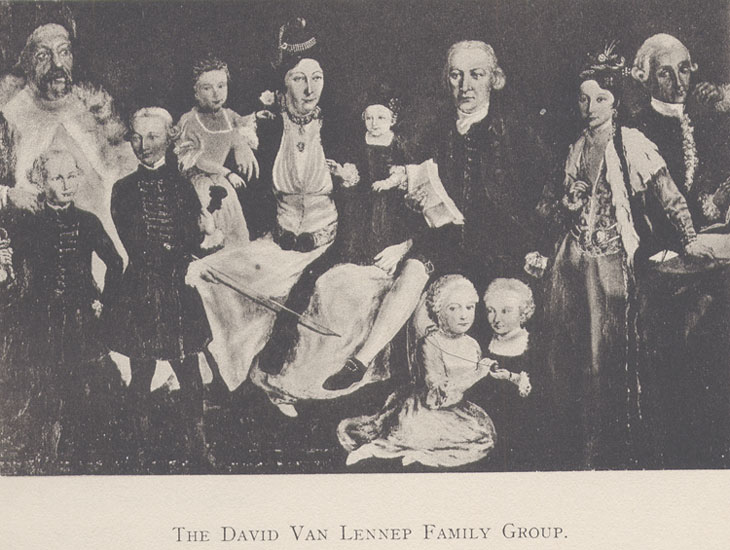 |
The names of these thirteen children were:- (figuring in the family group painting, read from left to right)
1- George Van Lennep.
2- Henry Van Lennep.
3- Mrs. Sara de Hochepied.
4- Jacop Van Lennep.
5- Lady Radstock - Countess Waldergrave.
6- Marquise de Chavannes de Tallyrand de Perigord.
7- Mrs. Lee.
After the portrait was made there came three more sons:-
Peter Van Lennep,
Richard Van Lennep,
Alfred Van Lennep,
and three daughters, as above stated:-
Clara, Mrs. Isaac Morier,
Susan,
Harriet.
Of the above-mentioned thirteen children, two children concern my family more particularly, and these are:-
1- Sara, because it is from her that we are all descended.
2- Richard, because our family has always been on terms of close friendship with many of Richard’s descendants.
Sara’s descendants having already been referred to, I give here the descendants of Richard, according to the information I have been given.
RICHARD VAN LENNEP married a Miss Edemstein and he had in all nine children, seven boys and two girls. The names of these nine children by order of birth are:-
1- Richard, his offspring (1) Richard, (2) Edward, (3) Lucien, (4) William.
2- Charles, his offspring (1) Charles, (2) Alfred, (3) Oscar, (4) Cyril, (5) Mrs. Ogilvie, (6) Mrs. Gorgievitch.
3- Henri, his offspring (1) William, (2) Edward, (3) Harry, all in the USA.
4- Gustave, his offspring (1) Gustave, father of (a) Anna, Mrs. Frank Whittall, (b) Esther, (c) Matilde, (d) Gustave, (e) Wigand, (2) Edouard, (3) Alfred.
5- Auguste, his offspring Fred and four other daughters.
6- David, no children.
7- Edouard, unmarried.
8- Eulalie, married to Auguste Arlaud, her offspring (1) Alfred, (2) Blanche, (3) Lucien, (4) Ernestine, (5) Lawrence.
9- Adeline, married to Mr. Homère.
My brothers must remember, just as I do, an old lady who very frequently came to visit our parents, and who was always referred to as “Tante Eulalie.” This old lady was the eighth child of Richard Van Lennep, Eulalie, who married Mr. Auguste Arlaud. The five children of Auguste and Eulalie Arlaud, were always on terms of great friendship and intimacy with our family. Alfred, the eldest son, who was a schoolmaster, was also for some years my tutor.
This brings us to a period more or less within the memory of the members of the Giraud family now living. So there is not much left for me to say that is not already perfectly well-known to my contemporaries.
Before bringing these notes to an end, however, I would like to refer to certain records that I have been able to obtain of other families in Turkey bearing the name of Giraud, that, as far as I can discover, are not in any way related to our family.
Firstly, as regards Consular Records, I have been assured that as far back as from 1750 and until 1806, the name of Giraud does not figure in any of the records of the French Consulate in Smyrna.
The Smyrna Consular Records of Girauds other than members of my own family have been given to me as follows:-
1er Mai, 1807. Birth of Marie Giraud, daughter of Jean Joseph François Giraud, “Natif de Sixfours et de Marie Pintelingo, née à Alicante.” It is of interest to know that Sixfours is a small town only a few miles south of Toulon and consequently not far from Antibes. Can Jean François Giraud have been related to Jean Baptiste Giraud? It is quite possible, though difficult to-day to specify anything definite on the subject.
12 Novembre, 1811. Birth of Joséphine, daughter of Augustin Giraud.
1812 to 1819. No entry regarding any Giraud.
1819 to 1829. Records burnt in 1922.
1829 to 1834. No entry regarding any Giraud.
8 Fevrier, 1835. Death of Augustine Giraud, aged 57 years.
5 Fevrier, 1838. Birth of Etienne, son of François Giraud.
30 Janvier, 1839. Death of Etienne, son of François Giraud.
10 Fevrier, 1840. Birth of Apolonia, daughter of François Giraud.
19 Janvier, 1842. Birth of Joseph Etienne, son of François Giraud.
19 Mai, 1844. Birth of Elise, daughter of François Giraud.
12 Janvier, 1846. Birth of François Victor, son of François Giraud.
In 1855. Death of Pierre Giraud.
15 Janvier, 1859. Death of Joseph Giraud (Matelot)
1861. Death of Joseph Giraud.
1874. Death of Marie Hélène Giraud.
At the same time, the Consular Authorities assure me that there must have been other Girauds “notoirement connus qui ne sont pas inscrits pour des raisons inconnues aux Registres de l’Etat Civil tenus au Consulat General de France à Smyrne.” The assurance thus conveyed is undoubtedly quite justified because I am myself acquainted with certain Girauds in Anatolia, claiming no relationship whatsoever to our family, who are not registered in the Smyrna Consular Records.
I have often met and conversed with an old man named Thomas Giraud of Kircagatch [Kırkağaç], one time Agent for the Oriental Carpet Manufacturers Ltd. in that district. I have also heard of Antoine Giraud, of Charles and of François Victor Giraud, all three of Ouchak [Uşak]. I am also, at the time of writing these notes, on terms of great and long-standing friendship with Joseph Giraud, married to Marguerite Mainetti, a descendant of Hélène de Jaba(née Giraud, my own ancestor), already referred to in these records. I have also heard of Mr. Octave Giraud, a French merchant of some importance in Constantinople. I have been credibly informed that some members of families in Athens to-day, married to Greeks, were née Giraud, such as, for instance, the wife of Dr. Andrikides of Athens. I am finally assured that the name Giraud, converted to the Greek “Znpo”, is borne by families existing in parts of Greece to-day.
The persons named above are, as far as I have been able to ascertain, direct descendants of François Giraud, and they have never at any time claimed any relationship whatsoever to our family.
From information given to me by descendants of the said François Giraud, François and his wife Marie, née Pintelingo, as soon as they reached Smyrna, acquired property and settled on their land at Kircagatch, where they brought up a large family, only a few of their children being registered at the French Consulate General in Smyrna. Several members of this numerous family actually became Rayahs or Greeks by naturalisation or marriage. Thomas Giraud who married Doudou of Kircagatch, above-mentioned, was a son of François and Marie and he is remembered by me as a grey-haired old man of large and portly build with a short well-trimmed white beard. He was for many years a member of the Municipal Council of Kircagatch and admittedly a Turkish subject. It is a well-known to me that a leading member of our Carpet Co. was instrumental in recovering French protection in 1922 for such of Thomas and Doudou Giraud’s children as were not already possessed of Greek or Rayah husbands or wives.
My friend and colleague, Mr. Joseph Giraud, above-mentioned, a grandchild of François Giraud, informs me that he is related to the Girauds of Constantinople, also mentioned above. Antoine Giraud of Ouchak was a brother of François Giraud of Kicagatch. François Victor Giraud of Ouchak was the son of François Giraud of Kircagatch, and Charles Giraud of Ouchak the son of Antoine Giraud of Ouchak above-mentioned.
I am not aware, however, of any other family bearing the name of Giraud in Smyrna or in any other family bearing the name of Giraud in Smyrna or in any other part of Turkey, and disclaiming relationship with either the François or Jean Baptiste Girauds. It does appear likely therefore that no other Girauds have been established in Smyrna or neighbourhood, nor is it at all probable that any other Girauds originating from the South of France about the end of the 18th or early 19th centuries settled in any other part of Turkey outside Smyrna.
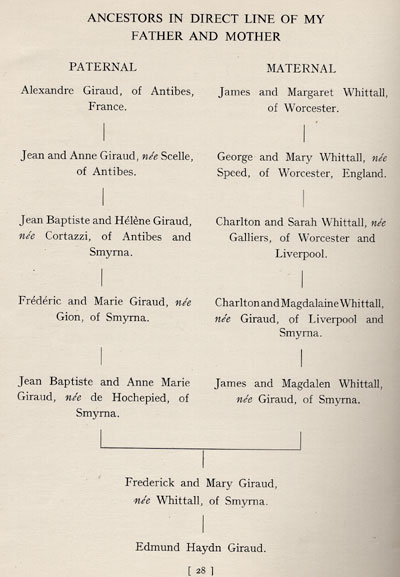 |
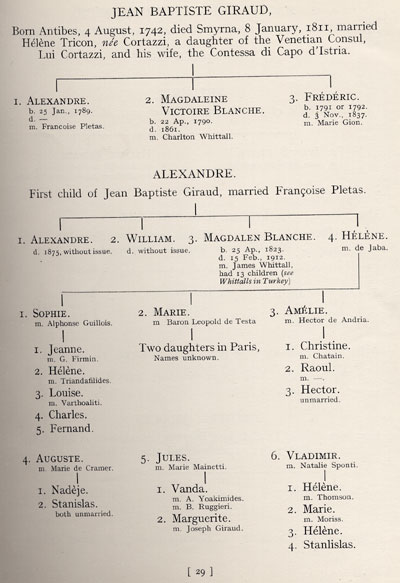 |
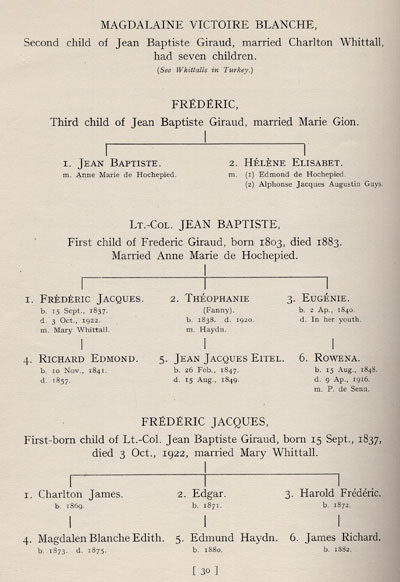 |
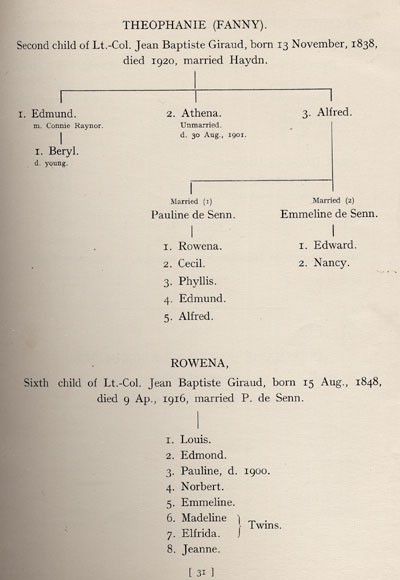 |
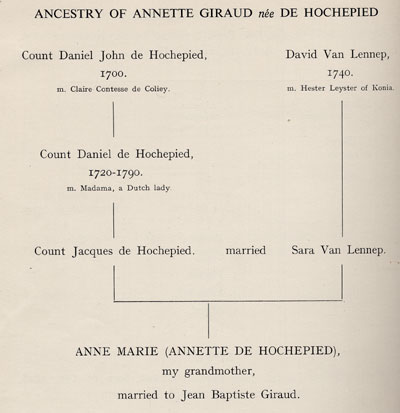 |
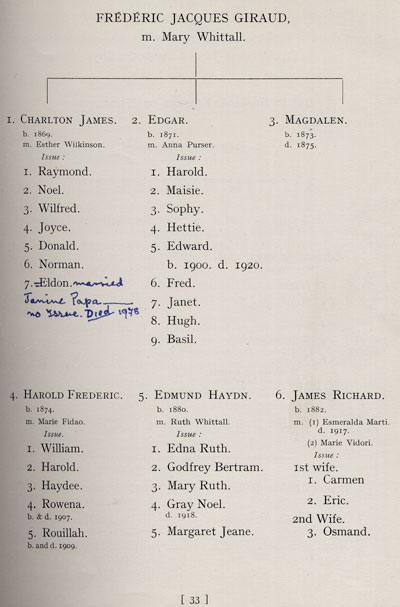 |
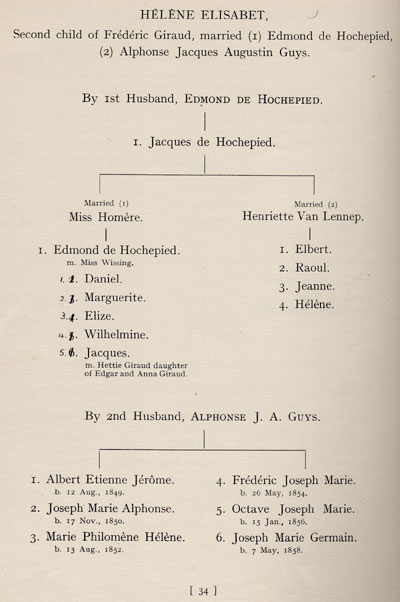 |
p.73
Towards the end of his career forty of the leading merchants of Smyrna, his “fellow citizens of all nations”, presented to Charlton an address elaborately printed on silk and worded as follows:-
“To
Charlton Whittall, Esquire,
Merchant
Smyrna
Charlton Whittall, Esquire,
Merchant
Smyrna
“Dear Sir,
“We, you fellow citizens, of all nations, respectfully beg of you to accept, as a mark of our esteem & friendship, the Portrait of Yourself, painted by G.E. Tuson, which we have now the honour to present to you.
“It is, in our humble opinion, a good likeness of one whose name will ever be remembered and cherished by us as much for his irreproachable honour as for his unbounded and never ceasing acts of charity and generosity; indeed, we feel that we cannot, on this occassion, convey our sentiments we are desirous to express in more concise or more eloquent language, than by quoting the words of Lord Redcliffe, when, alluding to you, he said that we had before us ‘a fine example of one who makes a noble use of ample means honorably acquired’; Laudari a laudato viro: to be appreciated by one who himself is so highly appreciated, not by his Country only but by the life in which he lives is the best proof of genuine merit.
“We have the honour to be
Dear Sir
Your most obedient Servants
“Sig:
| J.B. Paterson Edward Purser T.B. Rees James McCraith W. Forbes C. Hadkinson P.R. Gout Alexander Sidi Jacob Balladur Edwin Sydney Joly C.P. Charlton R.W. Cumberbatch E.D. Kupezoglou Samuel Bayliss |
C. Gandon A. Mirzan P. Homero Jos. Guidici Sebbah " Summa Fredk. Turrell Fred. Giraud A.O. Clarke J. Fillipucci Charles Wood J. Routier J. Malcozzi Alf. A. Robolly Ch. Corsi |
Et D. de Andria Stephen Maltass P.J. de Senne John K. Fisher A. Edwards F. Charnaud Aliotti Bros. G. Zeigler P. Aliotti J. Stab S. Reggio W.E. Browning |
At his death in 1867, Charlton Whittall bestowed on the Protestant Community of the Village of Bournabat by deed of gift, the Church and Churchyard that has ever since been used by the said Community as its place of worship now known as the Church of St. Mary Magdalene, Bournabat.
Thus did Charlton and his younger brother James settle down for the rest of their lives in Smyrna. They both got married early in life and both had fairly large families.
Charlton died on the 18th of June, 1867, at the age of 76. He had eight children, of which only two sons were married and had issue. He lies buried in the Anglican Cemetery of Bournabat.
James died on the 28th December, 1836, at the early age of 38 years. He had seven children of which also only two sons had issue. His death occured before the Anglican Cemetery in Bournabat came into existence and he lies buried in the old Whittall Vault situated in the Annexe of the Roman Catholic Churchyard burial ground in Bournabat.
The names of the eight children of Charlton Whittall and his wife Magdaleine Blanche Victoire Giraud, all born in Smyrna, were as follows:-
1.Richard born 31 May, 1815 died in Havannah in 1843
2. Charlton Arthur born 1816 died on board ship bound for Japan.
3. Helen born 3 Oct., 1817 died 25 February, 1827.
4. James born 20 Oct., 1819 died 3 February, 1883.
5. Frederick born 31 Aug., 1821 died 15 October, 1863.
6. John born 22 Sept., 1826 died in California.
7. William born 22 Mar., 1828 died 20 January, 1838.
8. Lucy Mary born 13 Dec., 1833 died ?
Of the above, three died in their youth, viz:-
Helen, aged 9 years.
William, aged 9 years.
Lucy Mary, in early youth.
Frederick died unmarried at the age of 42, from a fever contracted on his farm in the neighbourhood of Torbali in Anatolia.
Richard and John, I have been told, could not settle down to conditions in Turkey. The former died in Havannah in 1843, aged 28, and the latter in San Francisco in 1851, aged 24.
Amongst the famiy papers are two letters from Richard written only a short time before his death, and both letters are given at the end of this section. These letters are documents of pathetic interest, knowing as we do, that Richard succumbed to the climate and died in Havannah only a few months after the letters were written by him.
John was evidently the rolling stone of the family and the particulars of his death in California are likewise contained in a letter given at the end of this section.
The two remaining children, James and Charlton Arthur, settled in Turkey and will be referred later.
The names of the seven children of James Whittall and his wife Mary Schnell, likewise all born in Smyrna, were as follows:-
1. Emily born 9 June, 1826 died 20 May, 1911
2. James born 20 May , 1827 died 18 Dec., 1893
3. Mary born 12 Sept., 1828 died 1912
4. Charlton born 14 Jan., 1830 died 1893
5. Helen Blanche born 19 Feb., 1831 died 1886
6. Edward born 23 Ap., 1832 died 14 Ap., 1900
7. George born 6 Jan., 1833 died 13 May, 1836
Of the above, only one child, George, died in early youth aged 3 years. The remaining six children were all long-lived. Emily married a Mr. Bonnal. Mary and Helene Blanche died unmarried. All three sisters lived all their lives in Bournabat, and for the most part in the fine property known as “Cousin Mary’s” on the Bozalan, the house having been provided for them by their three brothers and built by the Architect Wood.
Charlton married Helen La Fontaine and settled down for life in the fine property known as the “Charltons” in the Square in Bournabat, where he brought up his large family. The property accrued to his wife by inheritance.
James and Edward, apart from family ties, never had any interest whatsoever in Turkey. Edward settled in Japan, married late in life and died childless. James entered the firm of Jardine Matthieson & Co., China Merchants. Later he left China and went to Ceylon, where he acquired large interests in the tea trade. He had a fairly large family, and with his brother Charlton, who also had issue, will be referred to later.
Richard, Charlton Arthur, James and Frederick, sons of Charlton, and James, Charlton and Edward, sons of James, were all sent to England at an early age to be educated, and whilst in England they were all taken charge by their Aunt Mary in Liverpool.
It is consequently from CHARLTON and his wife Magdaleine Giraud, through two of their eight children, namely,
Charlton Arthur, of Smyrna,
James, of the “Big House” in the Square, Bournabat,
as well as from his brother JAMES and his wife Mary Schnell, through two of their seven children, namely,
James, of Ceylon,
Charlton of the “Charltons” in the Square, Bournabat,
all born in Smyrna, that every single member of the many families deriving from these Whittalls, and now living in Turkey, as well as in many different parts of the world, is descended.
The two families of Charlton and James Whittall (the first two Whittalls to come to Turkey) comprised fifteen children. That only four of these children should have had issue would make it appear that the first Whittalls to reach Smyrna might possibly have had to face harder conditions than was generally supposed by later generations. It is difficult for anyone to say to-day with certainty if this was so. In a country and at a period in which early marriages and large families were the rule rather than the exception, it is difficult to think of any other reason. My own impression, based upon a study of family records of the past, is that both brothers at first had a very uphill road to travel on, and it was only steadfast application to business, combined with the strictest economy that enabled Charlton finally to raise the family to the high position it has since occupied.
It is certain, however, that with the increased measure of prosperity that accrued to the second generation born in Turkey, which brought to the family business in Smyrna and Constantinople the greatest degree of prosperity, the later Whittalls made up for any deficiencies, as the following single instance amply proves:-
James, of the “Big House”, Bournabat, had thirteen children, of which ten had issue.
These ten had ninety-one children, of which sixty bore the family surname, thirty being boys and thirty being girls.
Of these thirty boys, twenty-one were married and they had seventy-eight children of their own, of which thirty-six were boys and forty-two girls - to the end of the year 1931.
As soon as Charlton and his brother James reached Turkey they acquired property in the village of Bournabat, about six miles distant from Smyrna.
In those days and before the advent of the railway, the western extremity of the village was considered the best residential quarter. The finest houses surrounded by large gardens were all situated not far from the old fountain by the pine trees opposite the gates of the present Douglas Paterson property. It was at this fountain that gentlemen of substance met their little donkeys every morning to be carried to their offices in the city, and it is said that every donkey acquired the name of its patron and was never referred to by any other name. Jean Baptiste Giraud evidently owned other houses besides his own family residence in this part of the village, for it was one of his houses that Charlton rented and used as his country residence until 1819, when he bought the property for the sum of 25,000 piastres from the heirs of the late J. B. Giraud.
Later on, James acquired the two large plots of land in the then less fashionable part of the village. He bought the island site on which the Edwards and Clarke houses stand to-day, which he divided into two plots. After selling the larger of these two plots to Mr. Edwards, he bought the “Big House” property across the road, on which he built the first floor of the present “Big House”, for the purpose of occupying the same. At his death in 1836, or a few years later, the “Big House” property was acquired from his heirs by his brother Charlton, who bought the property at auction for the sum of 135,000 piastres. At about the same time, or shortly after, the field adjoining the Edwards’ property was acquired by James, one of Charlton’s sons, who built for his own use the house known later as the Clarke house, which to-day is occupied by Charlton and Mercy Whittall.
Charlton lived in the “Big House”, which at that time consisted of the ground floor or basement and the first floor only. His bedroom, I have been told, was in the basement, the north-west corner of the house, the reception and living rooms being on the first floor.
When Charlton died in 1867, his son James sold the Clarke property to Mrs. Azarian, it is said for the sum of five thousand gold Turkish pounds, and he acquired the “Big House”, which he enlarged by adding the second floor, and which to-day is the oldest property in the possession of the family in Turkey.
At about the same time, Charlton, one of the sons of James the Elder, married Helen La Fontaine, and he acquired through his wife the island property in the square and opposite the “Big House” gate, known to this day as the “Charltons”, the said house having been in the possession of the La Fontaine family until then.
Some years later, the three sons of James the Elder acquired for their sisters, Emily, Mary and Helen Blanche, the fine property at the Bozalan on which architect Wood built the large house known for many years as “Cousin Mary’s”. It has since passed into the ownership of the Varipati family.
These are the earliest residential property possessions of the family in Turkey. Since then and to this day various members of the James and Charlton Whittall families have acquired and still hold a large proportion of the best residential property in Bournabat, and have contributed in this way, as in other ways, more than any other family to the properity of this fine residential suburb of Smyrna. The family has likewise acquired and possesses to this day perhaps some of the finest residential sites in the whole of Turkey, in Moda, a suburb of Constantinople, where Sir J. W. Whittall and his descendants have been residing since about 1873.
In Smyrna, Charlton Whittall acquired, partly by inheritance through his wife and partly by purchase from the remaining two heirs of J. B. Giraud, his father-in-law, who died in 1811, the Frankhané, until then owned by J. B. Giraud. This same property was on the 29th June, 1868, acquired at auction by Charlton’s son James Whittall for the sum of £7,100. Since then it has been in the possession of the same family until destroyed by fire in 1922 - and was used for very many years chiefly as the offices of Messrs. C. Whittall & Co., Smyrna, and was known as the “Whittall Frenkhané”.
I will now record the information regarding the Whittalls of Turkey which I have acquired through personal contact with the family. There are living round me to-day relatives older than myself whose knowledge of the subject is considerably deeper than my own. I trust however that what I have to say will interest the rising generations whose numbers are so quickly exceeding those of us that have passed middle age.
THE JAMES WHITTALL FAMILY
My Grandfather JAMES must have been a methodical gentleman, to judge by his precise records of the family and by the care with which he preserved family relicts. I do not remember him, as he died when I was barely three years old. His portrait, a fine life-size painting, which to-day is in the possession of his eldest grandson, Mr. Edwin Whittall, of Moda, Constantinople, but which in my younger days I remember seeing so often in my grandmother’s dining room in the “Big House”, shows him as a dignified gentleman of somewhat advanced age. His sons, William, Fred and Herbert, very much resemble him.
My grandmother, Mrs. James Whittall, I remember perfectly, as she died in 1912 when I was 32 years of age. She lived in the “Big House” to the end and for many years she was decidedly the greatest personality not only of the entire family but of the village of Bournabat itself. She was the head of the family for twenty-nine years, and her strong character fitted her admirably for that position. For many years before her death she had an ever-increasing number of grandchildren and great-grandchildren growing up around her, and for some years in succession used to gather her descendants at Christmas for dinner in the dining and ball rooms of the “Big House”. At times over a hundred had to be seated. Before her death she kept to her rooms, which were on the left on the left of the entrance hall of the “Big House”. In her sitting rooms with her fully grown-up children habitually around her, she received the visits of her descendants from afar and of her numerous friends, in an atmosphere of great dignity and state.
My grandfather, James Whittall, married Magdalene Blanche Giraud, a niece to his mother and therefore a cousin to him. She was one of the two daughters of Alexandre Giraud and of his wife Françoise (née Pletas), who as a widow married W. B. Llwellyn, the said Alexandre being the son (oldest) of Jean Baptiste Giraud and Helen Cortazzi, his wife. I distinctly remember Mrs. Llwellyn, who was originally Mrs. Alexander Giraud (née Françoise Pletas). She lived for a number of years preceding her death in the two small rooms in the basement of the “Big House” giving on to the courtyard of the south basement entrance, and was known to me as my Great Granny. She was a short and rather thin old lady, who never failed to give us sweets when, as children, we called to see her, which needless to say was often enough.
A family group showing five generations of the family sitting together on the marble stairway at the entrance of the “Big House” consists of:-
Mrs. Llwellyn
Mrs. James Whittall
Sir J. W. Whittall
Linda Hill
Arthur Hill
It is a large oil painting and hangs at present in the Edward Whittall house in Bournabat.
With the birth of Wilfred Gardner (born June, 1910), son of Audrey, the eldest daughter of Mr. Edwin Whittall, for the second time the family had five generations living at the same time in the persons of:-
Mrs. James Whittall
Lady Whittall
Edwin Whittall
Audrey Gardner
Wilfred Gardner
It is to be regretted that they could not be conveniently grouped together for their portraits to be taken, as on the previous occassion above referred to.
I am informed that St. Mary Magdalene Church, built about 1857, was the gift of Charlton Whittall the elder to the Anglican Community of Bournabat in 1864, some years after his son James’s marriage. The church was so dedicated because the wives of both Charlton and James bore the name of Magdalene.
My grandfather James and his wife Magdalen had thirteen children, of which three are alive to-day. Of these, ten had issue, and all the ten, except Frederick George, who died in Bowdon, Cheshire, in 1896, lived to advanced ages and saw their children reach maturity. The names of the three children who died unmarried are:-
1. Helen, their second child, born 3rd July, 1840, died 31st December, 1841. She lies buried in the Budja Churchyard, and her grave was visited by me in 1932.
2. Charlton, born 1844, died 1864.
3. Edgar, born 1853, died 1865.
Edgar’s death was a particularly sad occurence, as he died in great suffering from hydrophobia.
The names of the seven married children that are dead are:-
James William, of Moda, Constantinople, died 1910, aged 72.
Jane Wilkinson, of Bournabat, died 1928, aged 86.
Richard Watson, of Bournabat, died 1920, aged 73.
Fredk. George, of Bowdon, died 1896, aged 47.
Edward, of Bournabat, died 1917, aged 66.
Herbert Octavius, of Bournabat, died 1929, aged 71.
Mary Giraud, of Bournabat, died 1932, aged 88.
Herbert Octavius, born in 1858, was the first child to be baptised in St. Mary Magdalene Church, Bournabat.
At time of writing, early 1933, three children survive and their names are:-
Blanche La Fontaine, born 1855.
Edith La Fontaine, born 1860. died April 19th 1946
Charlton Frank, born 1864.
My mother and my uncles and aunts, children of James Whittall, were brought up and educated in Turkey; all except Herbert Octavius, who was sent for two years to Christ College, Finchley, and Charlton Frank, who went to Bowdon College, Cheshire, where I too was educated.
James William, my eldest uncle (Uncle William), at an early age became connected with the firm of J. C. Harter & Co., of Manchester, and during the early part of his married life he resided in Bowdon, where his first three children were born. He left England in the very early seventies and shortly after, in 1872, he founded the firm of J. W. Whittall & Co., in Constantinople. In appearance he was fairly tall, well built, never inclined to stoutness and rather resembled his father. As long as I remember him, he wore a moustache and whiskers and later a well-trimmed beard. He was a man of substance, a sportsman and a great gentleman. He generally resided in his own property in Moda, one of the finest sites, perhaps, in the whole of Turkey. He married Edith Barker and eleven children.
Jane, my eldest aunt, married Richard Wilkinson, who was H.M.’s Consul in Manila, Salonica and Malaga. Aunt Jane was of medium height and never stout at any time. She had excellent features and a remarkably fine figure. Her manners were delightful. She had a great sense of humour and a very good memory, which she preserved to the end of her days. She was a most interesting and well-informed lady.
Richard Watson, Edward and Herbert Octavius lived their entire lives in Bournabat. The first two died in Turkey and lie buried in the Anglican Cemetery in Bournabat close to the resting place of their father and grandfather. Herbert left Turkey in 1922 and retired to Tunis, where he died in 1929. These three brothers were taken into partnership in the firm of C. Whittall & Co. of Smyrna by their father James in 1878; from the death of their father in 1883 they continued the partnership without interruption through a period of peace and prosperity that lasted for thirty-four years until 1917, when the death of Edward occured.
In appearance Richard was tall and of light and wiry build. He had a commanding presence and was always well dressed. Edward was more heavily built and more heavily limbed, without being stout. He never appeared as well dressed as Richard, his figure and gait perhaps lending themselves less to careful tailoring than that of his brother. Both Richard and Edward wore moustaches and Richard a well-trimmed beard.
Herbert was also a tall and substantially built man, yet with no superfluous flesh on him at any time. He bore a greater resemblance to his father than either Richard or Edward. All three brothers were great sportsmen, Richard being a crack shot with a game gun and Herbert a very experienced rifle shot. Richard in later years was devoted to duck shooting. He was particularly fond of the shooting at Mermer Göl, near Smyrna, where for many years he was well known and greatly loved and respected. Edward did all his shooting south of Smyrna, chiefly around Kulluk. In his later years he possessed a very pleasantly situated shooting lodge at Sakiz Bornou, near Sokia. Herbert was an experienced and successful big game hunter; most of his sport was obtained in Murad, the Ak and the Mairmum Daghs.He owned perhaps the finest collection of deer, ibex, bear and boar trophies in the country.
These three brothers differed somewhat in character. Richard was very open-handed and of genial and gay disposition, kind and generous to a fault. He was a great-hearted gentleman, a sportsman above everything, and his insticts caused him to delight in taking risks in every phase of life. Edward was likewise generous and open-handed, with perceptions perhaps a little less refined than those of his brother Richard. He delighted in an open-air life and loved sea fishing to an even greater degree than shooting. His particular hobby was gardening, to which he devoted himself throughout his life. He was perhaps least happy in the commercial atmosphere surrounding the important business operations carried on by C. Whittall " Co.
These two brothers had many traits of character in common and differed in a lesser degree from each other than Herbert differed from both. Herbert was a stern business man, inclined to be hard and uncompromising. He was a clear-minded and a purposeful man, who thought out every circumstance that had to be faced. For many years he was the guiding spirit in the affairs of C. Whittall & Co., and his influence predominated. He was always greatly respected and perhaps feared as well as loved, whereas his two brothers were loved for qualities that more often banished fear.
Richard married Marie Cramer and had fourteen children. He lived at the Bozalan in a fine house which he acquired from Mr. Alfred Barker. His open-handedness and hospitality were proverbial in his time.
Edward married Mary Maltass. He lived in one of the houses on the right-hand leading to the Station; then for some time in Tristram’s house before acquiring by purchase from the Corpi family the fine house and grounds which are now the family property. He had nine children.
Herbert married Louisa Maltass, and he always continued to live at the “Big House”, which became his property by purchase on the death of his mother in 1912. He had seven children.
Frederick George followed his brother William in the firm of J.C. Harter & Co., of Manchester, and I saw a great deal of him and his family in the years 1893-95, when I was at Bowdon College. My uncle then lived at Stamford Lodge, Chesham Place, Bowdon. Frederick was a mild-mannered man. He was very religious and much of his time outside business was taken up with parochial work at Bowdon. In appearance, in his early forties when I knew him, he seemed much older than his years. He was of medium height, rather thin and delicate, and never appeared to enjoy good health. He married Alice Preciosa Paterson, of Smyrna, and had fourteen children.
My mother, Mary, died less than twelve months ago. Her memory is as fresh to us all as is our knowledge of the three surviving children, Blanche, Edith and Charlton Frank, her sisters and brother. Of them it is quite unnecessary for me to write anything at all.
p.99
THE CHARLTON WHITTALLS
My great-uncle Charlton, who married Helen La Fontaine, died in 1893 at the age of 63, and when I was about 13 years of age.
As a child I was continually in contact with the family, the members of which were all greatly loved and respected, and extremely popular with their numerous relatives and friends about Bournabat.
The Charlton’s gate in the square, with its generous seating accomodation built around the finely situated garden entrance, was for many years the assembling place of the community and was usually crowded at nearly all hours of the day.
I remember my Great-uncle Charlton fairly well, though, of course, I was too young when he died to form an impression as to much beyond mere appearances. As I remember him, he was rather short in stature, not very stout, with a bald head, a somewhat prominent forehead, and a rather large nose. He habitually wore a small skull cap. Towards his later years he was often about in his garden giving attention to flowers in the hothouse opposite the main entrance of the house. My Aunt Helen stands more clearly in my memory. For many years after her husband’s death she lived a very retired life, and beyond being a regular attendant at Divine Service, she was not often seen about the village. She died in Egypt on the 23rd May, 1923, and lies buried at Alexandria.
The Charlton Whittalls have always lived in the property situated in the Square in Bournabat, which has ever been the family home until the death of Aunt Helen.
Charlton and Helen had twelve children, two of whom died in early youth and seven of whom are alive to-day. I do not remember the two children who died in their youth, as this occured before I was born. Their names were:-
WILFRED AUGUSTUS . . Born 1869, Died 1871.
THEOPHANIE AUGUSTA . . Born 1876, Died 1877.
They both lie buried in the Anglican Cemetery at Bournabat.
I remember the deaths of the other three children:-
OSCAR. Born 1870. Died 1887. His premature death was mourned by the entire community, for he died of typhoid fever contracted whilst in the hands, as a captive, of a band of brigands.
JAMES. Died in 1908 at the age of 43.
EDWARD. Died in 1923 at the age of 59.
Both James and Edward were on the staff of C. Whittall & Co. They were men of admirable qualities, fine gentelmen, and their loss was deplored by a wide circle of friends. Edward was a good sportsman and one of the best game-gun shots in Smyrna.
The seven children who are living to-day are well within the knowledge of the present generation.
The Charlton Whittall Family Tree is given below as far as the year of 1930 or thereabouts.
JAMES WHITTALL
Third son of Charlton and Sarah Whittall, of Liverpool. Born in Liverpool in 1798. One of the first Whittalls to come to Turkey with his brother Charlton and his sister Mary. Settled in Smyrna at an early age as a partner of C. Whittall & Co. Buried in the Whittall Vault, Roman Catholic annexe, Bournabat. Married Mary Shnell.
p.117
PREFACE
For some time past I have been engaged in typing out the histories of the “Early Whittalls”, the “Whittalls of Turkey”, and the “Giraud Family”, written by my cousin, Mr. Edmund Giraud.
This work has given me a taste of biographies, and I feel it would not be out of place if I, a humble member of our family, attempted to place on record all I know of our ancestors and of the generations within my personal recollection.
I cannot attempt a record as thorough and so strongly supported by documentary evidence as the histories written by Mr. E. Giraud. I am not in a position to trace the family to its places of origin such as NANCY and MONTAUBAN and other towns in France with which it was connected. Professional assistance could be called in, but this would mean an expense I cannot afford.
The only members of our family who, as far as I know, have taken an interest in the history of our ancestors are my Uncles Charles and Sydney La Fontaine. My Uncle Sydney had collected many important documents bearing on the family....
p.131
On another occasion, Monsieur Allamille of Montauban wrote to my Uncle Charles La Fontaine as follows:-
“Nous avons a Montauban deux familles du nom La Fontaine. L’une d’elles descendait de Monsieur Claude de Lafontaine ‘maistre Sellier’, natif de Nancy, qui avait epousé en Juillet 1645 à Montauban, Claire Courdine (Mar. fo. 159). Leur fille Jeanne, née en 1646 eut pour parrain Monsieur Daniel Dubedat, docteur et avocet (Bap. fo. 212). Leur fils, David, sellier comme son père épousa Francoise Debes (alias Bez) fille de feu Jean et de Jeanne Mariette en 1677 (Mar. fo. 82). David et Francoise eurent un fils nommé Claude le 28 Avril 1680 a Montauban (Baptist fo. 26). “En Angleterre on voit aux naturalisations en 1688 ‘Jacques de Lafontaine de la Rochelle’ [We have here in Montauban two families carrying the name La Fontaine. One of them descended from Mr Claude de Lafontaine ‘master Sadler’, native of Nancy, who married on July 1645 in Montauban, Claire Courdine (Mar. fo. 159). Their daughter Jeanne, born in 1646 had as a godfather Mr Daniel Dubedat, doctor and advocat (Bap. fo. 212). Their son, David, saddler like his father married Francoise Debes (alias Bez) daugher of Jean and Jeanne Mariette in 1677 (Mar. fo. 82). David and Francoise had a son named Claude in April 28, 1680 in Montauban (Baptist fo. 26). “In England one sees with naturalizations register in 1688 `Jacques de Lafontaine from La Rochelle’].”
Finally, in the Protestant Cemetery at Ferikioi, Istanbul, is a memorial monument bearing the following inscriptions:-
1637 David de Lafontaine.
1686 Justine Constance de Lafontaine.
1688 Abraham de Lafontaine (Dutch Consul).
1688 Abraham de Lafontaine (Dutch Consul).1688 Abraham de Lafontaine (Dutch Consul).
1740 Joana de Lafontaine.
THE MORIER FAMILY CONNECTED WITH THE LA FONTAINES BY THE MARRIAGE OF MARIE FRANCOISE MORRIER WITH JEAN GEDEON LA FONTAINE.
The father of Marie Francoise La Fontaine (née Morier) was Isaac Morier, of Vevey, near Lausanne. The family originally came from Chateau d’Oex, finally settling in Vevey. Isaac Morier married Jeanne Barbier, and, in addition to a daughter, the above Marie Francoise La Fontaine had a son named Jean Francois. Jean Francois married Elizabeth Grouch (of whom nothing so far is known). Their daughter was Francoise Adelaide Caroline, who was adopted and became the heir of Charles La Fontaine, my great-grand-uncle. It was at the instigation of his grandfather, Isaac Morier, that James La Fontaine, my great-grandfather, went to England and remained there long enough to be naturalised a British subject.
There appears to be another Isaac Morier, who was born in Smyrna in 1750, and was British Consul General in Constantinople from 1806 to 1817. He married a Clara Van Lennep, daughter of David Van Lennep, Dutch Consul General in Smyrna. According to my grand-uncle, Charles Constantine La Fontaine, this Isaac Morier was my great-grandfather, James La Fontaine’s first cousin, so apparently the Moriers of Vevey, Switzerland, and the Moriers of Smyrna were related, although there is no record in the possession of the family to prove this relationship.
Mrs. Isaac Morier, of Smyrna (née Clara Van Lennep), sister, married Admiral the Hon. William Waldergrave, afterwards Lord Radstock. Another sister married the Marquis de Chabannes de Talleyrand de Periford. Isaac Morier’s sons were:-
James Morier, author of Hadji Baba and Secretary of Legation at Teheran. He married Harriet, daughter of William Fulke Greville, died 1849. He accompanied the Shah of Persia to England and wrote an amusing account of the voyage. He was Consul General at Ispahan.
James Morier, author of Hadji Baba and Secretary of Legation at Teheran. He married Harriet, daughter of William Fulke Greville, died 1849. He accompanied the Shah of Persia to England and wrote an amusing account of the voyage. He was Consul General at Ispahan.
John Philip Morier, Minister Plenipotentiary at Dresden, married Horatia, daughter of Lord William Seymour, died 1853.
William Morier, Vice Admiral, died 1864.
David Richard, born 1874. David was the father of Sir Robert Morier, H.B.M.’s Ambassador to the Court of Russia and nephew to another James Morier who resided in Persia for many years.
In a book written by Sir Arthur Hardinge, A Diplomatist in Europe, mention is made of Sir Robert Morier, who was descended from Huguenot victims of bigotry of Louis XIV.; they emigrated, not to England, but to Switzerland, and one of them, Isaac Morier, moved still further afield to Smyrna and married Clara Van Lennep, daughter of the Dutch Consul and president of the Dutch Levant Commercial Co., “a girl,” so his descendant, Lady Weymess, tells us, in an interesting book, “of ability and remarkable beauty.” Two of the sons of that marriage went into the Diplomatic Service.
THE POSSIBLE CONNECTION OF OUR FAMILY WITH THAT OF JEAN DE LAFONTAINE, THE FABULIST.
The Fabulist, Jean de Lafontaine, who was originally a Protestant, became a Roman Catholic. There is only one very slender indication that the Fabulist and his family had some connection with our family, and this lies in the similarity of the Christian names of our family at the same period. Reference to Frank Hamel’s book on the Fabulist will substantiate this. The Fabulist was born in July, 1621, at Chateau Thierry (in the Capaigne) and married in 1647 (about the same time as our first known ancestor, Claude de Lafontaine, married) Marie de Hericourt. The Fabulist’s father was Charles de Lafontaine, and his mother was Francois Pidoux. Jean had a brother called Claude, who, it is said, took to monastic life when young.
The La Fontaines of Turkey
My great-grandfather, James La Fontaine, second son of Jean Gedeon La Fontaine and his wife Marie Francoise (née Morier), was born in Geneva. When quite young, he went to England at his grandfather’s - Isaac Morier, of Vevey - instigation, and after residing there for seven years, was naturalised a British subject, in the reign of George III.
The special act of Parliament naturalising James and a certain Nicholas Albert Martinus reads as follows:-
An Act for Naturalizing Nicholas Albert Martinus and James La Fontaine.
...a longer space than two months at any one time during the said seven years anything herein contained to the contrary not-withstanding.
I do hereby certify that the aforegoing is a true copy of the original Act in my custody as Clerk of Parliament.
Parliament Office, House of Lords, 20th August, 1924
Arthur T. Tring, Clev. Parliamentor.
JAMES, after becoming a member of the Honorable Levant Company, proceeded to Smyrna, where, in partnership with Edward Hayes, of London, he carried on business under the style of Hayes La Fontaine and Co.
JAMES married in Smyrna, in 1797, a Smyrna lady by the name of Maria Cocchini della Grammatica, of Venetian origin. Nine children were born of this marriage, their names being:-
1. Charles Constantine.
2. Frederick.
3. Edward.
4. James.
5. Marianne.
6. Caroline.
7. Henriette.
8. Anna.
9. Adéle.
JAMES died 3rd July, 1826, and lies buried in the Anglo-German Cemetery at the Point, Smyrna.
I recollect sending, some time in 1899 or 1900, to my Uncle Sydney an original letter written by James La Fontaine (in French) to his mother at Geneva giving a graphic account of a massacre in Smyrna. Many Christians were saved by Venetian galleys that happened to be in port. I believe also that JAMES’ passport and a certified copy of the Special Act of Parliament above quoted were sent at the same time. All these documents were destroyed during the events of 1922.
CHARLES CONSTANTINE, the eldest son of the above James La Fontaine, was born in Smyrna on the l4th October, 1798. He died at the age of 86, on the 23rd December, 1884, and lies buried in the British Cemetery at Haidar Pasha, Constantinople. CHARLES married in Smyrna a Smyrna lady, Marie Franceschi, who lies buried in the same Cemetery. They had no issue. I am indebted to my Uncle Sydney for the following brief sketch of the life of CHARLES CONSTANTINE :-
Charles La Fontaine, in connection with Zarifi Bros., of Constantinople, the Concessionaires, and at their request, undertook the management of the Pelion Silver Lead Mines m Macedonia, where at, or near Zaghora, a mill for crushing ore had been erected.
While in Macedonia, he was successful in bringing about the submission of a band of brigands (40 in number) that for years had been terrorising the country round about Zaghora. The Turkish authorities seemed powerless to capture or destroy the band, and, under the pressure of the British Embassy, he was authorised by the Turks to negotiate their surrender. After many meetings with the Authorities and brigands and the Chief of the band, the latter was induced with all his men to submit, the condition being that all the members were to be pardoned and incorporated in the Gendarmerie at a fixed wage. The Turks assented, after some hesitation, to all the conditions. Charles, after some months, resigned his appointment m Macedonia and returned to Constantinople, and shortly after his arrival was offered and accepted the Directorship of the Ottoman Bank at Smyrna, in either 1856 or ’57. He did not remain very long in Smyrna, for after the resignation of Mr. Ede, who was Director of the Bank in Constantinople, he was transferred to the Capital in Mr. Ede’s place, his brother, Frederick, in the meantime being appointed at Smyrna. Several years afterwards, a number of British and French financial magnates obtained an Iradé from the Sultan Abdul Medjid to establish the Imperial Ottoman Bank with branches all over Turkey. The Ottoman Bank ceased to exist and was merged into the larger institution. Charles was transferred to the Dette Publique at Stamboul as Director General which appointment he held until a year before his death on the 23rd December, 1884. For services rendered to the Turkish Government during the reign of Abdul Medjid and his able Minister of Foreign Affairs and Vizier, Rechad Pasha, Charles received the Medjidieh and later on the high insignia of the Nishani-Iftihar in brilliants, as well as several gold enamelled snuff-boxes. He was decorated by the Shah of Persia who conferred upon him the order of the Lion and the Sun. When the 1851 Exhibition in London took place, under the auspices of Prince Albert, the Queen’s Consort, Charles was appointed member of the Turkish Section of the Exhibition and received the Prince Albert Medal in recognition of his services, i.e., preparing and selecting the exhibits with Turkish members of the Section.
Previous to his connection with Zarifi Bros., Charles was the senior member of the firm of Hayes La Fontaine & Co., Smyrna and Constantinople, after his father’s death in 1825. He and my grandfather, Edward, managed the Constantinople Branch. His brother Frederick was the Director of the firm in Smyrna. The firm of Hayes La Fontaine and Co. was liquidated about the year 1852 or 1853.
CHARLES CONSTANTINE, was a personal and intimate friend of Lord Stratford de Redcliffe, the powerful British Ambassador of that period, known to the Turks as the “Grand Elchee”. He was also an intimate friend of Vice-Admiral Sir Adolphus Slade (Mushaver Pasha), who was, during the reign of Abdul Medjid, the Naval Advisor and Reformer of the Turkish Navy. A presentation gold watch and chain, actually in my possession, bears the following inscription:-
Souvenir
of
Vice-Admiral Sir Adolphus Slade
K.C.B.
to his old friend
Charles Constantine La Fontaine
My grand-uncle, Charles Constantine, died a few years after I was born but I clearly remember hearing a lot of authentic stones about him when I proceeded to Constantinople m 1897 at the age of 16 to enter my father’s business. These stories were related to me by an old sportsman, whose name I do not recollect, who accompanied Lord Stratford and my grand-uncle Charles on their shooting expeditions, by an old cook who had been for many years in my grandfather’s employ and finally my father’s devoted clerk, Pascal Seraphim, who retired two years after I entered the firm, after accomplishing 45 years service with my father and grandfather. The impression made upon me by these stories and the perusal of many old papers, mostly copies of correspondence written by my grand-uncle and contained in several tin boxes, was that grand-uncle Charles was a very remarkable man. His photo, which was hung up in my Aunt Alice’s sitting room, when I was a young man, showed a remarkably strong face of most aristocratic appearance. I think it can be safely said that his services to his country and to the Turkish Government and his remarkable reputation for character and nobility of sentiments which are remembered even to this day, easily place him as the most important personage our family has produced. An article which appeared in the Levant Herald of Constantinople (in 1884) shortly after his death states:-
“While our paper was under interdict a highly valued member of the British Community passed away in the ripeness of an advanced old age. Charles Constantine La Fontaine, a familiar figure in this capital for the last 65 years, and who was in the 86th year of his age, was gathered to his fathers on the 23rd December, 1884, rich in good repute of his long and unblemished life. The profound respect in which this estimable member of the Community was held was shown by the throng that attended his obsequies. The details of his life will interest a large number of our readers, for he was connected more or less directly by ties of relationship with almost every family of standing in the Levant, and by the yet stronger bond of respect with every inhabitant of this Empire for the last three-quarters of a century. Therefore we have collected from authorised sources the following particulars of his life, no less remarkable for its variety than for the native simplicity of the man, and for his honourable holding of the even tenour of his way through vicissitudes of singular abruptness.
“Charles Constantine La Fontaine was born at Smyrna on the14th October, 1797. He was the eldest son of James La Fontaine, who settled in Smyrna in 1786. His ancestors were Huguenots of French extraction, residing at Montauban, who after the revocation of the Edict of Nantes, sought refuge in Switzerland. James La Fontaine, son of John Gideon La Fontaine and Francoise Morier, was born and educated at Geneva, but later on, at the instigation of his uncle, Mr. Isaac Morier, he left Geneva and proceeded to London. While there, he and several other Huguenots were naturalised British subjects by Special Act of Parliament (Geo. III.). He subsequently was admitted to the freedom of the Honourable Levant Company (whose Charter dates from 158l in the reign of Queen Elizabeth) and left London for Smyrna, where he established himself as Merchant in connection with the firm of Morier and Wilkinson.
“Charles Constantine La Fontaine, after completing his studies at Smyrna, under the careful training of a Swiss tutor, was sent at an early age to Constantinople. He also repaired thither in 1821 during Sir Robert Liston’s Embassy. At that time however, he was in such delicate health, that at the request of his medical adviser, he started for Egypt, where he remained a year. He later on undertook a voyage to Trieste in a sailing vessel, again for the benefit of his health, and from thence proceeded overland on a trip through the Continent, subsequently crossing over to England. Whilst there he became in 1824 a Member of the Levant Company, and on his return eastwards through France, was fortunate enough to meet at Toulon a great friend of his father, Admiral de Rigny, who offered him a passage to Smyrna in his flagship “La Siréne”. Admiral de Rigny was then about starting on a mission to Greece in connection with the Greek Revolution. During the voyage which was bountiful of interesting events, Mr. La Fontaine, who often acted as interpreter to the Admiral, had rare opportunities of following up the phases of that momentous and noble struggle which had sent a thrill through Europe, and had enlisted in its cause so many champions of liberty. At Missilonghi, where the frigate remained some days, he made the acquaintance of the late Dr. Julius van Millingen, Lord Byron’s medical adviser.
“In 1825 Mr. La Fontaine was again sent by his father to Constantinople, where he started a branch establishment of the firm of Hayes La Fontaine & Co. In the following year was enacted the terrible tragedy of the massacre of the Janissaries, so horrible in its details, but so beneficial in its results. The British merchants resided at that time in what is now the Perchembé Bazaar quarter, and a number of those mercenaries who appealed to them for shelter were stowed away in their cellars. One of them, Kara Ibrahim, who in later years many have met at Tophane scala, was one of the Janissaries saved. A few years later, through the joint influence of Prince Mettemich and the Austrian inter-nuncio in Constantinople, Count Sturmer, Mr. C. C. La Fontaine although a British subject, succeeded in obtaining for himself and his brothers the agency of the Danube Steam Navigation Company, the pioneers of steam trade in the Levant. This Agency, the firm of Hayes La Fontaine & Co. retained for the space of 10 years when for reasons more political than expedient, the steamers of the Danube Steam Navigation Company, plying between Constantinople and the Levant Ports, were withdrawn to make room for those of the Austrian Lloyds.
“In the year 1846, Mr. C. C. La Fontaine and the late Mr. Chas Hanson, together with the Hon. H. Wellesley, formed the special Commission appointed by H.B.M.’s Government for the settlement of the celebrated Tripoli claims. For his services in this matter, which occupied several years in adjusting, he and his colleagues through the Foreign Office, received the thanks of the British Government.
“In the year 1853, after the liquidation of the firm with which he was connected, Mr. C. C. La Fontaine accepted the Directorship of the Pelion Silver Lead Mines, the concession of which had been obtained from the Turkish Government by the late Mr. George Zarifi. It was during his stay in the village of Zaghora and the Mill that he negotiated the surrender and pardon of the famous band of brigands, who for years had terrorised over the surrounding country and whose haunts, the dense forests of Pelion, Mr La Fontaine often visited alone, his only companion being one of the brigand guides. In one of his parleys with these bandits, he was recognised by one of them (an ex-lieutenant m the service of Grivas), who introduced himself as an old acquaintance, they having met before, so the brigand averred, under the hospitable roof of the great Eltchi.
“The Pelion mines having given unsatisfactory results, Mr. C. C. La Fontaine returned to Constantinople m 1855, about which time the charter of the Ottoman Bank was granted. He accepted the post of Director of the Smyrna Branch offered him by Sir Henry Layard, the then Chairman of the Board in London. Subsequently, in 1858, he was transferred m the same capacity to Constantinople and m 1863, when the Ottoman Bank was merged into the Imperial Ottoman Bank, the Marquis de Ploenc appointed him Director of the Stamboul Public Debt Office, which position he held up to his death.
“For services rendered at different intervals to the Turkish Government in the reigns of the Sultans Mahmout and Abdul Medjid, he received the Nishani-Iftihar and the Medjidié, the former in brilliants. He was likewise decorated with the order of the Lion and the Sun by the Shah of Persia. Abdul Medjid regarded him with great favour, and on three occasions presented him with jewelled snuff boxes in token of his friendship and esteem.
“During a residence in this country of over half a century, he witnessed many political changes, the barest record of which would have added an interesting chapter to the history of the period he traversed. All that was known by his friends of his past life and more especially of his experiences of an epoch in Ottoman history of so wide a range, was gleaned from him in personal intercourse. He left no diary or notes behind him.”
The Levant Herald was a well-known British newspaper published at Pera, Constantinople, and edited by Mr. Edgar Whitaker. The details appearing in the above article were communicated and written by my Uncle Sydney at the request of the Editor, who added several eulogistic remarks confirming the esteem and consideration in which Charles Constantine La Fontaine was held by the British members of the Community and in Turkish circles.
FREDERICK, the second son of James La Fontaine, was born in Smyrna on 2nd November, 1800. He died on the 24th February, 1870. He lies buried in the Anglo-German Cemetery at the Point, Smyrna. He married twice, his first wife being a Smyrna lady, Adéle Escalon, and his second, Anna Coccinou.
By his first wife he had four children :-
1. Helen, born on 17th October, 1836, died in --, who married Mr. Charlton Whittall, of Bournabat, Smyrna. She had 11 children.
2. James Stephen, born on loth July, 1837, died on 2ist August, 1920, who married Helen Barker, of Smyma. He had three children.
3. Theophanie Adelaide (Fanny), born 27th June, 1842, died 9th May, 1917, who married Dr. Augustus Werry, of Moda, Kadiköy, Constantinople. She had no children.
4. Frederick Charles, born 19th January, 1847, died 19th July of the same year.
By his second wife, Anna Coccinou, Frederick had one child, Freda, who is unmarried. Frederick was the Manager in Smyrna of the firm of Hayes La Fontaine & Co. until its liquidation, in 1852 or 1853. He subsequently became the Manager of the Ottoman Bank in Smyrna.
RICHARD JAMES, third son of James La Fontaine, was born at Budja, Smyma. He died at a comparatively early age from the effects of goring by a wounded wild boar when out shooting. He was unmarried. He lies buried in the Anglo-German Cemetery at the Point, Smyrna. James was an amateur painter and a small painting which, in my youth, was in the possession of my Aunt Alice, showed a singularly handsome face.
EDWARD, my grandfather, the fourth son of James La Fontaine, was born in 1806 at Budja, Smyma. He died on the i6th October, 1886, and lies buried in the British Cemetery at Haidar Pasha, Constantinople. He married Lydia Maltass, of Smyrna, and had six children :-
1. Alice Eliza, unmarried, still living, aged 94.
2. Ida Maria, married Edward Barfield, died December, 1929.
3. Charles Henry, married (1) Grace Barker, (2) Emily Barrow, still living, aged 91.
4. Sydney James William, married Edith Amelia Whíttall on the 18th December, 1882, golden wedding celebrated. on 18th December, 1932, still living, aged 89. Died 19/4/1946
5. Edward Augustus John, my father, married Blanche Whittall, died 4th March, 1899.
6. Linda Helen, unmarried, died 1920.
Edward managed, along with his eldest brother, Charles Constantine, the Constantinople branch of the firm Hayes La Fontaine & Co. After its liquidation m 1852 or 1853, he started business on his own account and in his name during the Crimean War, 1853-56, acting as Agent for several British Steamship Companies and trading besides in coal, copper, iron and pitch. In later years, he was the Agent of the Bibby Line of Steamers (subsequently Fredk. Leyland & Co.) and the Royal Insurance Co. The firm of Edward La Fontaine, now Edward La Fontaine’s Sons, exists to this day. The first and only recollection I had of my grandfather was when I was taken, with my cousin Wilfred La Fontaine, to see him just before his death. I could not have been more than five years old at that time and yet my recollection of the scene is still vivid.
MARIANNE FRANCOISE, the eldest daughter of JAMES, was born at Budja, Smyma, on the 22nd October, 1804. She died on the 28th March, 1878, and lies buried at the British Cemetery, Haidar Pasha. She married Samuel Barker and had four children as follows :-
1. Alfred, married Eveline Charnaud, died at Moda, Kadıköy.
2. Julia, unmarried, now dead.
3. Maria, unmarried, now dead.
4. Edith, married Sir J. W. Whittall, still alive aged 95.
CAROLINE NICOLETTE, born 11th December, 1810, second daughter of James La Fontaine, married John Charnaud. She had six children as follows:-
1. Eveline, married Alfred Barker, now dead.
2. Harriet, unmarried, now dead.
3. Lily, unmarried, now dead.
4. Henry, married in England and died there.
5. Edwin, married Edith Barker, now dead.
6. Charles, now dead, married (1) Agnes Barker, (2) Milbah Johnson. One of his children, by his second wife (Stella), is now Marchioness of Reading.
HENRIETTE CHRISTINE, born 19th September, 1813, third daughter of James La Fontaine, died 12th December, 1846, unmarried.
ANNA, fourth daughter of James La Fontaine, married John de Jongh, Dutch Consul in Smyrna. She had one child, Anna, who died in Smyrna, unmarried.
ADELAIDE, born 19th July, 1819, fifth daugher of James La Fontaine, married Dr. Julius Van Millingen (his third wife), who was one of the doctors attending on Lord Byron at Missilonghi, Greece. She had two children: Julius, who was manager, for a time, of the Ottoman Bank, Stamboul; and Edwin, the famous oculist [eye doctor]. Both are now dead.
The descendants of the nine children of James La Fontaine and his wife, Maria Cocchini, are either alive or, if dead, within the recollection of the surviving members of the family. It would be superfluous therefore to refer to them in this small history. An exception should, however, be made in the case of the following members of the family who fought for their country in the Great War of 1914-1918:-
Hubert, second son of Sydney La Fontaine, joined up in 1914 as Aide-de-Camp to General Hanington. As District Commissioner at Taveta, he was attacked by the German forces of German East Africa, but succeeded in making good his escape with the four men under his charge. This engagement was alleged to be the first British engagement in Kenya colony. For his services, he was awarded the D.S.O. and M.C. He was mentioned three times in dispatches. An O.B.E. was conferred on him two years ago. He is actually Native Commissioner of Kenya Colony.
EDWARD, fourth son of Sydney La Fontaine, was “Officer de Liaison” attached for a time to a French Brigade at Salonica. He was given the Croix de Guerre and was mentioned twice in dispatches. He was given the M.B.E. and the Greek Croix de Guerre.
SYDNEY JAMES, fifth son of Sydney La Fontaine, was severely wounded in the war on the Gallipoli Front. He died in 1932 of the result of the wound, which never healed.
CECIL, sixth son of Sydney La Fontaine, on leaving Uppingham, joined the Army. He went through his military training and was ordered to the front. Before he got there the Armistice was signed; he thus saw no service.
WILFRED JAMES, eldest son of Charles Henry La Fontaine, served from March, 1917, to the end of the War, with rank of Lieutenant R.N.V.R., in Athens, Alexandria, Syra and Mudros.
FREDERICK, second son of Charles Henry La Fontaine, volunteered at the commencement of the War as an ordinary soldier. He joined the Rifle Brigade and fought in the front line of many of the important battles in France. He was wounded on three occasions, and possesses the following medals: M.B.E. Military, 1914-15 Star, General Service, Victory Medal with Bar (mentioned in dispatches), Greek Order of the Redeemer, Greek Cross of Merit. He eventually obtained a Commission and was transferred to the Salonica Front, where he joined the Intelligence and was promoted to Staff rank. He spent the first few years of the Armistice in Constantinople until he was demobilised.
JAMES EDWARD, the eldest son of Edward La Fontaine, remained in Turkey to supervise and liquidate the interests of the firm of Edward La Fontaine & Sons (of which he was then the senior partner), and to act as guardian of his widowed mother and unmarried sisters. He was arrested and exiled to Tchorum [Çorum] in November, 1915, but liberated a few months later by Talaat Pasha, the Prime Minister, for services rendered to Eyoup Sabri Bey, General Secretary of the Union and Progress Party, when the latter was interred at Malta. On the 17th July, 1917, he was again arrested with four other Englishmen (Dr. Frew of Constantinople, being one of the party) and interned at Modjour, a small village not far from Caesarea [Kayseri]. He was released in December of that year, thanks to the efforts of Rahmi Bey, the enlightened Governor of Smyrna, whose extraordinary generous and considerate treatment of enemy subjects will ever be remembered by those who lived, during the war, in Smyrna. James Edward returned to Constantinople a few days before the arrival of the allied fleets, and was thus able to re-establish the interests and connections of the firm and enable it to take fuller advantage of the short term boom that followed the Armistace.
HUGH, third son of Edward La Fontaine, volunteered at the commencement of the War as an ordinary soldier. Obtained a Commission and was transferred to the Salonica Front in the Intelligence. He was promoted to the rank of Captain and is the holder of several medals. During the first few weeks of the Armistice he was head of the Military Police on the Asiatic side of the Bosphorus.
Bornova, Izmir, Turkey, 23rd May, 1934.
This font colour denotes to later hand-written text in book.
Click here to view a selection of archive Whittall family photos
Click here to view a selection of archive La Fontaine family photos
Click here to view a simplified and one line of the Whittall and allied family tree